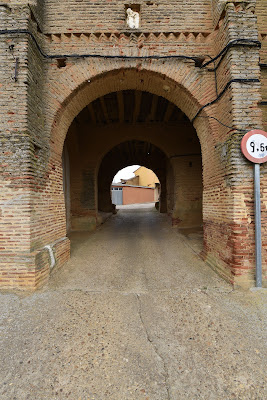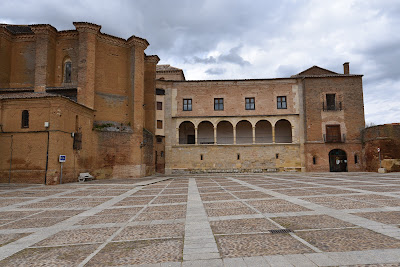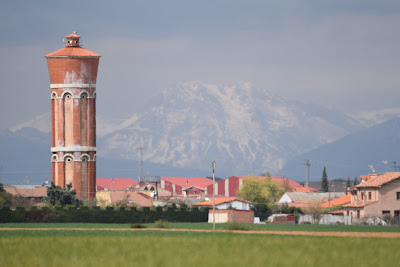Cerrado, Cerrado, Cerrado : Villalon de Campos to Sahagun
Cerrado, Cerrado, Cerrado
Camino de Madrid meets Camino Frances
Today we finished the Camino de Madrid portion of our pilgrimage, and the ending was entirely perfect - the albergues and bars were 'cerrado' right up until the very end. Nonetheless, it was a beautiful walk, the weather was gorgeous, and it was a phenomenal wildlife day.
We left the albergue just as the sun was rising, being careful not to wake the hospitaleros, who were out late last night. We made our way to the centre of town, hoping to find breakfast, but nothing was open yet, and there were no signs that anything was about to open in the near future. Once again, we set off down the trail with empty bellies, hoping to find breakfast somewhere along the way.
We followed the winding red dirt trail out into rolling fields of brown, green, and yellow. The slanting golden rays of the rising sun were illuminating the young green crops and creating curving shadows across the rolling hills. The sky was a clear blue, the air was cool and still, and the only sounds were those of birds singing. Looking back we could see Villalon de Campos behind us. It was a beautiful morning.
Fontihoyuelo Spain
We cruised through the peaceful morning, stopping frequently to watch and photograph the birds. Around 8 km into our hike, we came to the tiny village of Fontihoyuelo. Our arrival was ungracious - through a farm whose large and odoriferous manure pile had escaped onto the trail, creating a short section of boot-swallowing muck. At first, I worried that the scruffy dog lying in the mess was dead, but it turned out to be merely lethargic. An equally depressed-looking cat watched us as we passed the barn, where someone inside was angrily yelling and banging around.
As we crested the hill and descended into the rest of town conditions improved slightly, and a beautiful view opened up in front of us, revealing a snow-covered mountain range beyond rolling green fields. As our guidebook suggested, this town offered no amenities for hungry hikers. We stopped at a bench outside the church and for the second day in a row contented ourselves with a few slices of baguette and some jam we had purchased in Villalon de Campos.
Wild Turkeys and Open Fields
We continued our hike across the meseta, struck by the incredible beauty of the landscape around us. Conicle trees and umbrella conifers dotted the landscape of green fields through which our red track snaked. In the distance tall snow-covered mountains loomed.
We were constantly entertained by the enormous wild turkeys dotting the fields around us. The males posed on hills and ridges, trying their best to attract the girls, while others faced off against each other, never flinching.
Santervez de Campos
Around 11 AM we arrived in Santervez de Campos, where we had been hoping to stay last night, but had never gotten an answer from the Albergue. The trail once again seemed to weave around the edges of town, but we chose to climb the steep hill to the Ponce de Leon Museum, which is also the location of the Albergue.The museum was closed, as was the Albergue, but we stopped to admire the bronze statue of Ponze de Leon and read about his achievements. Juan Ponce de Leon was a Spanish explorer and conquistador who was born in 1474 in Santervás de Campos and went on to become leader of the first official European expedition to Florida. He later served as the first governor of Puerto Rico. Interestingly, he first came to America as a 'gentleman volunteer' with Christopher Columbus' second expedition in 1493.
Swallows and Deer
After walking past the museum we searched for an open bar or café and came up empty, so we walked to the edge of town and took a break at a group of picnic tables along the Camino. We were in a tiny park shaded by trees, just at the edge of the road. As we took a break we watched a group of over a dozen swallows collecting mud from a puddle in the dirt road.
One group dragged their beaks back and forth in the mud, flying off with huge clumps of sticky, heavy mud entirely covering their bills. The other group arrived with small bundles of sticks in their beaks which they coated with mud before flying off. It must be a nest-building day!
Before setting off we refilled our water bottles at the nearby fountain and came across a small ditch in which Sean spotted a beautiful frog with a bright green stripe down his back.
At this point, we had reached the suggested end of this stage of Camino de Madrid, but since it was still relatively early and we'd had no success in reaching the albergue, we continued on. It was another 8 km across relatively flat, open fields to the next tiny town of Arnillas de Valderaduey. This town seemed to be decomposing. Piles of bricks, broken roof tiles, and assorted debris formed heaps among the weeds at the edge of town. The bricks of the adobe walls were melting and falling down, and those of the church tower and walls were sloping and bowing. It seemed like the place was slowly sinking into the earth.
After quickly making our way through town we crossed a small footbridge and then found ourselves following a dirt track down the side of a small canal. It was so full of life that our pace dramatically slowed down. Birds flitted in and out among the trees, and frogs could be heard calling down by the water. Perhaps best of all, a small deer scampered ahead of us through the trees before crossing the canal with a huge crash and splash. It was magical, and Sean ended up photographing several new bird species.
Grajal de Campos
Around 2:30 PM we came to the final town on the Camino Madrid, where we had hoped to stay for the night. Grajal de Campos boasts not one but two castles, the Church of San Miguel, with its Mudejár architecture, and a colonnaded central Plaza Major. The albergue is in one of the castilles, and we had hoped to stay there. Unbeknownst to us, on Tuesdays the Albergue is only open until 3:00pm. Although we arrived at 2:30 PM, there was no one there, the door was locked, and no one answered either of the phone numbers on the door. We went to the local bar and had a cold cerveza, waiting to see if we could get a response. We called the numbers listed three times more in the next half hour, with no answer. The town hall was listed as opening again at 4:00 PM, so we waited to see if anyone would arrive who could let us in. Those at the local bar laughed at our attempts to get in as if we were making some kind of joke. By 4:45 PM, sitting at the door to the albergue and town hall with no one there or showing up, we simply gave up and decided to walk the final long kilometres to Sahagun.
Cerrado to the End
Our journey along the Camino de Madrid has been incredibly beautiful, but since the beginning, it has been plagued by holidays, regional days off, temperamental hospitalerios, and closures. To us, it felt entirely fitting that each albergue in the final kilometres remained cerrado until the very end. When we finally entered Sahagun we learned that the place to get credentials for the Camino de Madrid is now permanently closed as well - how else could this end? Even the volunteers at the central albergue in Sahagun were stunned to discover that there was a route that came from Madrid.
Rejoining the Camino Frances
When we walked into Sahagun it didn't look even remotely how we remembered it when we passed through on our walk along the Camino Frances. We saw it with new eyes and from a new perspective. On the one hand, we very much enjoyed finding food for the first time in several days, finding accommodations that were open, and hearing English spoken around us by other pilgrims. On the other hand, the prevalence of shells, bars and streets named for peregrinos, as well as the many references to the Camino made us feel a little like we'd left Spain and Spanish culture behind and entered into a pilgrim corridor built more for tourism than reflection. I guess the next few days will give us a better understanding of what the Camino Frances is and has become.
Distance: 46 km
.JPG)
.JPG)
.jpg)
.JPG)
.JPG)
.JPG)
.JPG)
.JPG)
.JPG)
.JPG)
.JPG)
.JPG)
.JPG)
.JPG)
.JPG)
.JPG)
.JPG)
.JPG)
.JPG)
.JPG)
.jpg)
.JPG)
.JPG)
.JPG)
.JPG)
.jpg)
.JPG)
.JPG)
.JPG)
.JPG)
.jpg)
.jpg)
.JPG)
.JPG)
.JPG)
.JPG)
.JPG)
.JPG)
.JPG)
.JPG)
.JPG)
.JPG)
.JPG)
.JPG)
.JPG)
.JPG)
.JPG)
.JPG)
.JPG)
.JPG)
.jpg)
.JPG)
.JPG)
.JPG)
.JPG)
.JPG)
.JPG)
.JPG)
.jpg)
.JPG)
.JPG)
.JPG)
.JPG)
.JPG)
.JPG)
.JPG)
.JPG)
.JPG)
.JPG)
.JPG)
.JPG)
.JPG)
.jpg)
.JPG)
.jpg)
Comments
Post a Comment